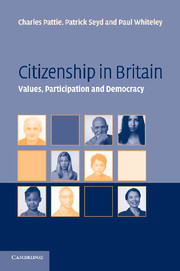A - The Citizen Audit: Technical Details
Published online by Cambridge University Press: 22 September 2009
Summary
Sampling method
The Citizen Audit is a stratified, clustered, random sample of adults aged 18 or over. The sampling frame for the face-to-face part of the survey was the Postcode Address File (PAF). Private households only were selected from the PAF; people living in institutions were excluded. For the mail survey the sampling frame was the 1999 electoral register. The selection of respondents involved three separate stages:
Selection of local authorities
At the first stage, 101 local authorities were selected in England, Scotland and Wales. Using Census sources local authorities were stratified on the basis of:
population density
region of the country
Selection of addresses
For the face-to-face survey, three postal districts were selected randomly in each local authority by Business Geographic. Within each of these postal districts twenty households (sixteen to be contacted, plus four spare ones to substitute for missing households) were selected at random. In the mail survey 238 addresses were selected per local authority.
Selection of individuals
Interviewers called at each selected address and listed all those eligible for inclusion in the sample, that is all persons currently aged 18 or over and resident at the selected address. The interviewer then selected the person within the household who had the next birthday. In the mail survey names and addresses were selected randomly from the 1999 electoral registers.
Weighting
The raw data file was weighted by age, sex and employment status to make them consistent with Census data in order to compensate for non-response.
- Type
- Chapter
- Information
- Citizenship in BritainValues, Participation and Democracy, pp. 287 - 288Publisher: Cambridge University PressPrint publication year: 2004



